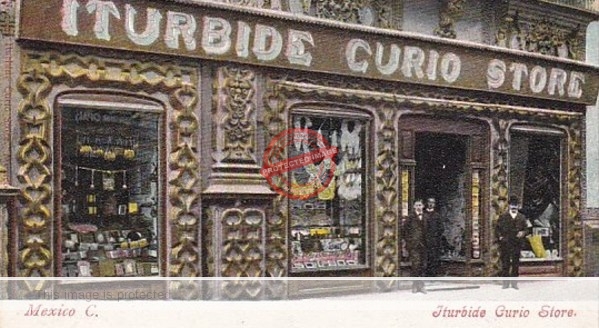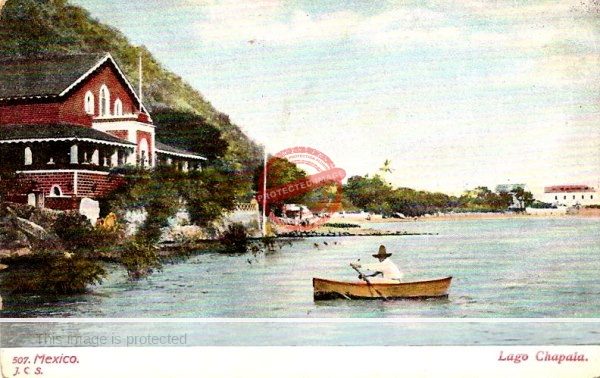At the start of the twentieth century, Jacob Kalb, a Jewish immigrant of Austrian ancestry, owned and operated the Iturbide Curio Store in downtown Mexico City. The store, selling all manner of Mexican tourist souvenirs and mementoes, opened in 1903 on the ground floor of the Hotel Iturbide. The hotel occupied the historic Palacio de Iturbide (Iturbide Palace), a superb 18th century Mexican baroque building that survives to this day. It was bought and beautifully restored in 1965 by the Banco Nacional de México (Banamex) and is now the Banamex Cultural Foundation (Fomento Cultural Banamex).
The Iturbide Curio Store was one of several competing curio stores in that area at that time, including one run by Jakob Granat, one of Kalb’s nephews, across the street. (Granat also published at least one postcard of Chapala.)
No expense was spared when Kalb opened his store in 1903. Carefully selected wares were displayed in elegant showcases, all beautifully illuminated by electric lighting, a relatively recent innovation.

Iturbide Curio Store (publicity postcard image)
Soon afterwards, Kalb started to publish postcards (both monochrome and color), using various different imprints, ranging from ““Iturbide Curio Store” and “J.C.S” (typesetters of the time often used the letter J in place of the letter I) to “J.K.”
Kalb did not credit the photographer on his cards but at least one card utilizes a photograph taken by Charles Betts Waite, a noteworthy American photographer based in Mexico City at that time.
Kalb published dozens of cards of Guadalajara, some with undivided backs (and therefore pre-1906 in date). These early cards include the only known image of Lake Chapala published by Kalb. This attractive view of Casa Schnaider (Villa Josefina) with the Hotel Arzapalo in the background, was published in about 1904; a postally-used example was mailed the following year. The pretty, European-style ‘cottage’ was originally named Villa Albion, and had been built by the eccentric Norwegian-born Englishman Septimus Crowe in 1896, after he sold the Villa Montecarlo. In 1901, Crowe sold Villa Albion to the US-born Guadalajara beer magnate Joseph Maximilian Schnaider, who promptly renamed it Villa Josefina, in honor of his wife. More than a century later, the property continues to bear this name.

Photographer unknown. Lake Chapala. Iturbide Curio Store postcard #507. c. 1904.
Kalb published this image at least twice, with minor modifications. The “Iturbide Curio Store” version, numbered 228, had a wider white band along the bottom and a flag fluttering from the Villa Josefina flagpole. When Kalb reissued the photo as a “J.C.S.” edition, the image was slightly cropped and the flag removed.
Kalb produced several hundred postcards in total, covering the entire country and designed to appeal to the widest possible cross section of the rapidly increasing flow of tourists exploring Mexico.
In 1906, Kalb advertised in a Mexico City paper that he had the largest stock of picture postcards of Mexico. A collection of 100 views cost $2.00; the wholesale price was $16.00 for 1000.
My 2022 book Lake Chapala: A Postcard History uses reproductions of more than 150 vintage postcards to tell the incredible story of how Lake Chapala became an international tourist and retirement center.
Sources
- Valentina Serrano & Ricardo Pelz. “Serie azul y roja de Jacobo Granat.” Presentation at 8th Mexican Congress on Postcards, Palacio Postal, Mexico City. 16-18 July 2015.
- Arturo Guevara Escobar, 2012. “Jacobo Kalb, una lectura diferente. Parte I“, blog post dated 1 March 2012
Comments, corrections and additional material are welcome, whether via the comments feature or email.
Tony Burton’s books include “Lake Chapala: A Postcard History” (2022), “Foreign Footprints in Ajijic” (2022), “If Walls Could Talk: Chapala’s historic buildings and their former occupants” (2020), (available in translation as “Si Las Paredes Hablaran”), “Mexican Kaleidoscope” (2016), and “Lake Chapala Through the Ages” (2008).
Thanks— not the place here to truly discuss but this wonderful presentation to see via words and cards early 1900s Mexico always makes me wish to understand the decline Mexico went through from I guess the early 1930s–through the 1990s. The Mexico city here was far more vibrant than the Mexico city I spent almost a month in during 1971. Mr. Burton, thanks, I need another lifetime to figure this transition out but I so appreciate, via your books, articles and research the bricks you deliver to help build that picture and solve the puzzle.
thanks for explaining the Kalb / Granat relationship – I couldn’t figure out how they were across the street from each other in roughly the same business.
Bob, You’re very welcome! TB